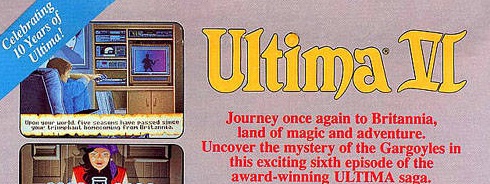Ultima 6 Was Released 30 Years Ago

IF you can believe it, Ultima 6: The False Prophet was released exactly thirty years ago today. Yes, it has been that long.
Arguably, Ultima 6 still represents the best that the Ultima series has to offer, though it might also be fair to say that it offers the best overall combination of the elements we’ve come to expect an Ultima game to be comprised of.
The gameplay of — and technology underpinning — The False Prophet is solid; the turn-based engine can suffer from some stuttering in areas where there are many creatures (foes or otherwise) moving about, but in the main the game feels snappy and easy to navigate. The control scheme, a hybrid of mouse and keyboard interactions, simplifies the often-complicated control sets of previous Ultima titles. The inventory system has drawn some criticism from some fans, to be sure, though it can’t really be said that Origin Systems got inventory better with Ultima 7, or even Ultima 8. Ultima 6’s inventory is probably the most mouse-centric aspect of its interface, so for those playing it for the first time without a mouse (hey, it was 1990!), there would certainly have been some struggle there. But in terms of general overall playability, Ultima 6 does still represent some of the best of Ultima, especially for how well its combat is realized (this, really, is where its turn-based engine shines).
(It’s worth noting, too, that the Ultima 6 engine was the first RPG engine that Origin Systems re-used for other games; two Ultima spin-offs were later crafted with it. It was also considered for use as the engine for a Star Wars-themed game, though that never came to fruition.)
The world design in Ultima 6 is also excellent. Britannia is detailed and feels expansive; this was the first Ultima game to move away from the dual-scale worlds that had characterized the series previously, instead opting to present a single (and massive) monoscale Britannia to players. Towns and wilderness on the same contiguous map might not seem that impressive by modern standards, but it was a revelation back in 1990.
The strongest aspect of Ultima 6, though, is its story, which remains one of the most brilliant examples of trope subversion in the RPG space to date. Ultima 6 tries — and tries hard — to make you think that it’s a basic “kill the monsters/save the land” sort of tale, and then it rather suddenly pulls the rug out from under its players and turns that idea around. Because really, if you do in fact kill all the “monsters” (read: Gargoyles), you can’t win the game. At all. It’s impossible. Ultima 6 takes that not-uncommon fantasy trope and turns it into a story where the resolution is to find (or force, depending on how you look at it) a compromise between two warring sides, between the no-longer-entirely-noble Britannias and the unexpectedly-not-monstrous Gargoyles.
In some respects, the tale told by Ultima 6 feels like a very natural endpoint of where Origin Systems had been taking us with the stories told in Ulitma 4 and Ultima 5. Ultima 4 introduced us to the Eight Virtues, and Ultima 5 explored what happened when those Virtues became corrupted. Ultima 6, though, was about actually living the Virtues in some way…not in the sense of accruing points in each, but in the sense that players needed to actually look at the problem presented by the game’s plot through the lens of their own sense of Justice, of Compassion, and suchlike, and through that come to understand how to actually solve the central problem of the game.
Ultima 6 was, in short, a masterwork of a game. One that has now been entertaining us for three decades.

















































